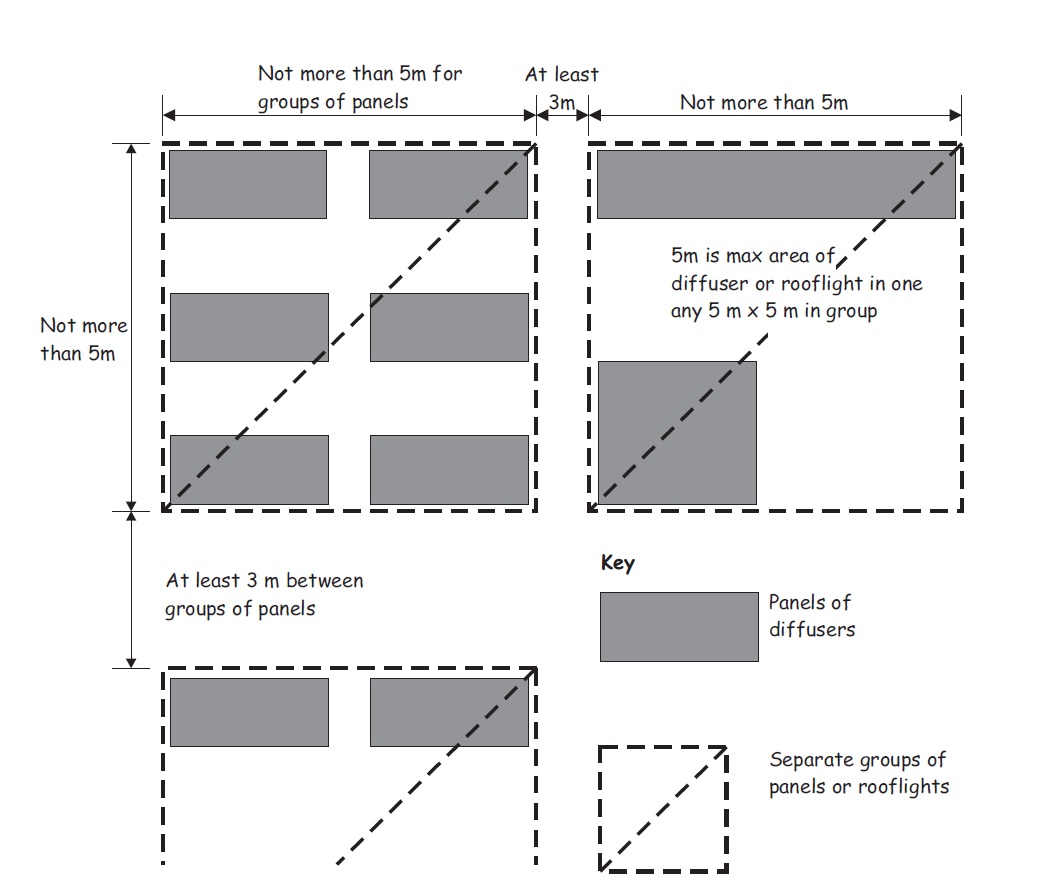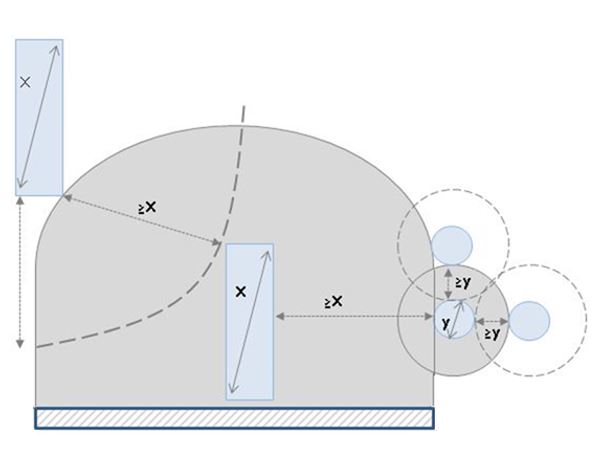2.5 Internal linings
|
The building contents are likely to be the first items ignited in a fire and are beyond the scope of this guidance. Materials used in walls and ceilings can however significantly affect the spread of fire and its rate of growth. Fire spread on internal linings in escape routes is particularly important because rapid fire spread in protected zones and unprotected zones could prevent the occupants from escaping.
Conversions - in the case of conversions, as specified in regulation 4, the building as converted shall meet the requirement of this standard (regulation 12, schedule 6).
Wall and ceiling surfaces mean the substrate or lining material including any treatment thereof to restrict flame spread, but excludes any decorative wallpaper or paints. Whilst it is accepted that such wallpaper or paints are not controlled by the guidance, multiple layers applied to the face of a wall or ceiling surface can increase flame spread and hence the fire growth rate. For this reason, multiple layers are not recommended when carrying out refurbishment work involving the re-decoration of wall and ceiling surfaces.
Every room, fire-fighting shaft, protected zone or unprotected zone, should have wall and ceiling surfaces with a reaction to fire which follows the guidance in the table below:
Table 2.4. Reaction to fire of wall and ceiling surfaces (see annex 2.E)
| Building | Residential care buildings and hospitals | Shops | All other buildings |
|---|---|---|---|
| Room not more than 30m2 | Medium risk [2] | High risk | High risk |
| Room more than 30m2 | Low risk [3] | Medium risk | Medium risk [4] |
| Unprotected zones | Low risk | Low risk [5] | Medium risk |
| Protected zones and fire-fighting shaft [1] | Low risk | Low risk | Low risk |
Additional information:
-
Including any toilet or washroom within a protected zone.
-
High risk in a room not greater than 4m2.
-
Ceilings may be medium risk.
-
Low risk in storage building (Class 1).
-
In an enclosed shopping centre, structural timbers supporting glazing that forms part of a shop front, unit signs and stallboard risers can be constructed of materials which are low, medium or high risk provided they are not more than 20% in total, of the area of the shop front.
Limitations on higher risk surfaces - in a room, any part of the wall may be of one risk category higher than that recommended in the table above, but not very high risk, where the total area of those parts in any one room is not more than half the floor area of the room. This is subject to a maximum of 20m2 in residential buildings and 60m2 in non-residential buildings.
In a building solely housing livestock, the surfaces of unprotected zones may have any level of reaction to fire, except very high risk.
Wall and ceiling linings should be assessed for their reaction to fire characteristics.
Wall linings - the following wall surfaces should be included in the assessment:
However the following surfaces need not be taken into account:
-
doors and door frames
-
window frames and frames in which glazing is fitted
-
skirtings and facings, cover moulds, picture rails and similar narrow members, and
-
fireplace surrounds, mantle shelves and fitted furniture.
Ceiling linings - the following ceiling surfaces should be included in the assessment:
-
the surface of glazing
-
any part of a ceiling which slopes at an angle of 70º or less to the horizontal.
However the following need not be taken into account:
-
ceiling hatches and their frames
-
the frames of windows or rooflights and the frames in which glazing is fitted
-
facings, cover moulds, picture rails and similar narrow members.
External windows and internal glazing to rooms (but not to protected zone or unprotected zones) may be fitted with plastic glazing materials which are:
-
rigid solid PVC (uPVC), or
-
polycarbonate rigid solid sheet at least 3mm thick, or
-
multiskin polycarbonate sheet at least 10mm thick overall which has low or medium risk.
Thermoplastic materials in ceilings, rooflights and lighting diffusers provide a significant hazard in a fire. Burning droplets can rapidly increase the fire growth rate and the smoke produced is normally dense and toxic which combine to produce extremely hazardous conditions. For these reasons, thermoplastic material should not be used in protected zones or fire-fighting shafts. However thermoplastic materials may still be used with limited application for some ceilings (see clause 2.5.5), rooflights (see clause 2.5.6) or light fittings with diffusers (see clause 2.5.7).
A thermoplastic material means any synthetic material that has a softening point below 200ºC when tested in accordance with BS EN ISO 306: 2004 Method A120 Plastics - Thermoplastic Materials - Determination of Vicat softening temperature.
Rigid Thermal Plastic TP(a) rigid means:
-
rigid solid (solid as distinct from double or multiple-skin) polycarbonate sheet at least 3mm thick, or
-
multi-skinned rigid sheet made from unplasticised pvc or polycarbonate which has low or medium risk for reaction to fire, or
-
any other rigid thermoplastic product, a specimen of which (at the thickness of the product as put on the market), when tested in accordance with Method 508A in BS 2782: 2004 performs so that the test flame extinguishes before the first mark, and the duration of flaming or afterglow does not exceed 5 seconds following removal of the burner.
Flexible Thermoplastic TP(a) flexible means:
-
flexible products not more than 1mm thick which satisfy the Type C provisions of BS 5867: Part 2: 1980 (1993) when tested in accordance with Test 2 in BS 5438: 1989 (1995) with the flame applied to the surface of the specimens for 5, 15, 20 and 30 seconds respectively, but excluding cleansing procedure.
Semi-rigid Thermoplastic TP(b) semi-rigid means:
-
a rigid solid polycarbonate sheet product not more than 3mm thick, or multiple-skin polycarbonate sheet products which do not qualify as TP(a) by test, or
-
other products which, when a specimen of the material more than 1.5mm and not more than 3mm thick is tested in accordance with Method 508A in BS 2782: 2004, has a rate of burning which is not more than 50mm/minute.
A ceiling constructed from thermoplastic materials, either as a suspended or stretched skin membrane with a TP(a) flexible classification should be supported on all sides and each panel should not exceed 5m2 per panel. However this does not apply to a ceiling which has been satisfactorily tested as part of a fire resisting ceiling system. A ceiling with a TP(a) flexible classification should not be installed in the ceiling of a protected zone or fire-fighting shaft.
Subject to clauses 2.5.6 and 2.5.7, the use of thermoplastic materials with a TP(a) rigid or TP(b) semi-rigid classification is unlimited.
Thermoplastic materials (other than TP(a) flexible) may be used in rooflights subject to the recommendations in the table and diagram below.
Thermoplastic rooflights should also be constructed in accordance with the guidance to Standard 2.8.
Thermoplastic materials may be used in light fittings with diffusers. Where the lighting diffuser forms an integral part of the ceiling, the size and disposition of the lighting diffusers should be in accordance with the table and diagram below.
However where the lighting diffuser forms an integral part of a fire resisting ceiling system which has been satisfactorily tested, the amount of thermoplastic material is unlimited.
Where light fittings with thermoplastic diffusers do not form an integral part of the ceiling, the amount of thermoplastic material is unlimited provided the lighting diffuser is designed to fall out of its mounting when softened by heat.
Table 2.5. Thermoplastic rooflights and light fittings with diffusers
| Protected zone or fire-fighting shaft | Unprotected zone | Room | ||||
|---|---|---|---|---|---|---|
| Classification of lower surface | Any thermo-plastic | TP(a) rigid | TP(a) flexible and TP(b) | TP(a) rigid | TP(a) flexible and TP(b) | TP(b) |
| Maximum area of each diffuser panel or rooflight (m2) | Not advised | No limit | 5m2 | No limit | 5m2 | 1m2 |
| Maximum total area of diffuser panels or rooflights as a percentage of the floor area of the space in which the ceiling is located (%) | Not advised | No limit | 15% | No limit | 50% | 50% |
| Minimum separation distance between diffuser panels or rooflights (m) | Not advised | No limit | 3m | No limit | 3m | A distance equal to the largest plan dimension of the largest diffuser or rooflight (see figure 2.2) |
Additional information:
-
Smaller panels can be grouped together provided that the overall size of the group and the space between any others, satisfies the dimensions shown in figure 2.1 below.
-
The minimum 3m separation in the diagram below should be maintained between each 5m2 panel. In some cases therefore, it may not be possible to use the maximum percentage quoted.
-
TP(a) flexible is not recommended in rooflights.
Additional information
-
X = Maximum dimension of the largest diffuser or rooflight above.
-
Y = Maximum dimension of the smallest diffuser or rooflight above.
A sandwich panel is a factory-made, non load-bearing component of a wall, ceiling or roof consisting of a panel having an insulated core filling the entire area between sheet metal outer facings, which may or may not have decorative and/or weatherproof coatings.
A sandwich panel used for internal walls or linings in a residential building should have a non-combustible classification.
A sandwich panel used for internal walls or linings in a non-residential building should be designed and installed in accordance with the ‘Design, Construction, Specification and Fire Management of Insulated Envelopes for Temperature Controlled Environments’, International Association of Cold Storage Contractors (European Division), 2008.

